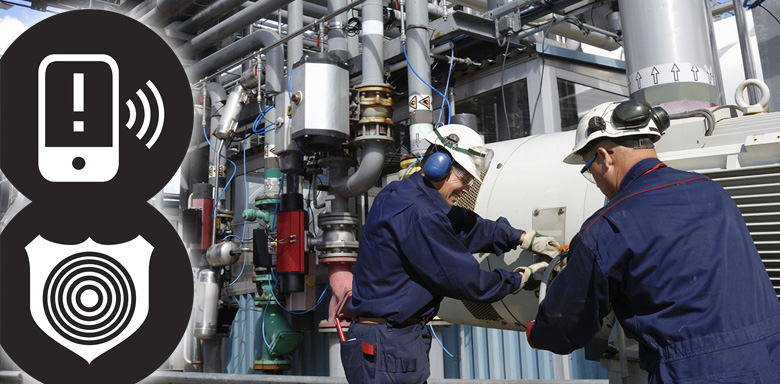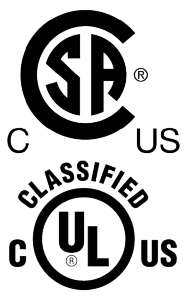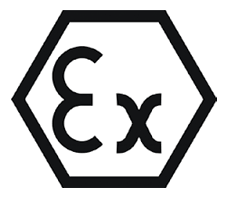
The phrase “Intrinsically Safe” is often used generically to describe products destined for hazardous (explosive) areas. This post explores the term “Intrinsically Safe”, provides an overview of what is required to certify a product and compares Intrinsic Safety against Explosion Protection concepts.
Intrinsic Safety – The basics
The term “Intrinsically Safe” (IS) is frequently used to describe any product destined for an explosive area. In reality, IS is a protection concept based around limiting the available electrical energy to nonincendive levels so that sparks cannot occur from short circuit or failures which could cause an explosive atmosphere to ignite.
A typical fixed IS circuit would comprise a device such as a temperature sensor permanently located within the explosive area, which is in turn protected by a safety barrier located in the safe area. These barriers usually incorporate a series of diodes, resistors and fuses arranged and sized in such a manner that they limit the energy provided to the device in the field. Interestingly, the inclusion of a barrier in the control loop does not allow any device to be connected downstream. Even though the power may be limited, the device located within the explosive area itself must also be designed to comply with the requirements of various regulatory standards depending upon the geographical locale of the plant.
Certification standards
Across the world, there are differing regulations and requirements which dictate how products are designed, developed, certified and manufactured in order to be sold to a customer as IS certified.
Some examples of IS standards are:
- Europe: EN60079-1:2007
- United States: Factory Mutual – FM3610
- Canada: CSA C22.2 NO 157.92-CAN/CSA
Although each of these standards defines the requirements for a device to be certified as IS, the requirements of each are different. These differences range from the effects of static build-up on non-metallic casings to the assessment of cells, even the test parameters themselves may be different. The bottom line is that it is not possible to claim a product certified as intrinsically safe in Europe to EN60079-XX (ATEX) can be deemed as intrinsically safe certified in the United States or Canada and vice versa. For each country, the device should be tested in accordance with the local requirements. Once tested and certified, products are marked as part of their manufacture.
Who verifies intrinsic safety?
Equipment is tested and certified for intrinsic safety by independent third-party agencies, such as Underwriters Laboratories (UL), Canadian Standards Association (CSA), Factory Mutual Research Corporation (FM) and the Mine Safety and Health Administration (MSHA). Some of these various agencies throughout the world can certify to the standards produced from another – meaning UL labs can certify an instrument to a CSA standard, which the manufacturer would then display the cUL mark on their product.
U.S. and Canadian Standards
Class I, Division 1, Groups A, B, C, D; Class II, Groups E, F, G; Class III
CSA or UL Mark: United States and Canada Safety Standards
 An electrical, mechanical or electro-mechanical product bearing the North American CSA or UL Listing mark signifies that it was tested and meets the minimum requirements of prescribed safety standards. Moreover, the mark indicates that the manufacturer’s production site conforms to a range of compliance measures and is subject to periodic follow-up inspections to verify continued compliance. A CSA or UL Listed device with both “US” and “C” labels at the lower left and lower right of the CSA mark respectively, signifies that the product bearing the mark complies with both U.S. and Canadian product safety standards.
An electrical, mechanical or electro-mechanical product bearing the North American CSA or UL Listing mark signifies that it was tested and meets the minimum requirements of prescribed safety standards. Moreover, the mark indicates that the manufacturer’s production site conforms to a range of compliance measures and is subject to periodic follow-up inspections to verify continued compliance. A CSA or UL Listed device with both “US” and “C” labels at the lower left and lower right of the CSA mark respectively, signifies that the product bearing the mark complies with both U.S. and Canadian product safety standards.
United Kingdom and Europe
Zone 0, 1, 2; Group IIC, IIB, IIA, I
The “Ex Hexagon” mark: United Kingdom and Europe Safety Standards
 Intrinsically safe devices covered by the ATEX Directive can be separated into two distinct options notably “Ex ia” and “Ex ib” devices. Devices with the former designation are designed to be safe even after a second order failure of the safety system and are suitable for use in Zone 0 hazardous (explosive) areas. Ex ib devices are designed to operate after a first order failure and as such are suitable for Zone 1 hazardous (explosive) areas.
Intrinsically safe devices covered by the ATEX Directive can be separated into two distinct options notably “Ex ia” and “Ex ib” devices. Devices with the former designation are designed to be safe even after a second order failure of the safety system and are suitable for use in Zone 0 hazardous (explosive) areas. Ex ib devices are designed to operate after a first order failure and as such are suitable for Zone 1 hazardous (explosive) areas.
Similar to the CSA mark described above, a product bearing the Ex Hexagon has not only been designed and tested to meet the minimum requirements of the relevant ATEX safety standard but also the production facility has sufficient controls to ensure safe manufacture of the device itself. Annual audits are carried out by safety bodies to ensure that these standards are being adhered to and products designed are safe.
Field Exceptions to Consider
As with any rule, there are of course, exceptions! Let’s assume that we have plant located in Canada comprising of a Class I Div 1 hazardous (explosive) area. We need to take a tablet with a digital camera into that area to document equipment during normal operation. Ideally, the device used should have been certified to the local standard which defines the requirements for safety. However, what if no such device exists? What are our options?
Option 1: Use a standard “off-the-shelf” tablet with permits.
This can be attempted, but it requires significant time and effort to raise hot-work permits, risk assessments and method statements plus supplementary safety equipment such as gas detectors to use the tablet. And all this effort does not ensure the device will even pass and therefore be accepted for use.
Option 2: Attempt to obtain a device that holds a certification similar or greater than that of the hazardous area with permits.
For example, a tablet that has been tested for use in explosive areas; but these tests were only performed to European standards, or the device is certified to Class I Div 2 areas. In either scenario, the safety features of this device obviously exceed those of an off-the-shelf tablet. The plant safety officer would need to assess the tablet and its certification along with the task required of it to determine acceptability, but this is normally a one-time task rather than raising permits for every trip when opting for Option 1.
Explosion proof technology – Why use it??
Okay, so IS equipment is usually light, compact and robust, everything we need for a portable device. So, why would anyone want to use explosion proof (XP) as a protection concept?
The answer is simple: power.
With an IS system the entire power of the system – which includes but is not limited to the batteries – is controlled. This means that inductive and capacitive loads are also assessed to the extent that they cannot cause a spark.
These limitations can cause problems when a device needs to operate in a power range higher than allowed. High Voltage Switchgear for example could never be considered IS as the power in the conductors is far higher than that accepted by the IS standard.
By using XP as a protection concept, “high” power devices can be used safely in an explosive area. The XP device itself is designed and tested to contain any explosion which may occur within, protecting the operator and the facility from harm.
Design requirements – XP devices
From a basic design standpoint, an explosion proof device must be able to withstand an explosion within the enclosure and allow escaping gas to cool as it expands and passes through the flame paths transiting from inside the enclosure to the environment outside. These flame paths are carefully calculated and manufactured to extreme tolerances in order to achieve the desired cooling effect.
XP devices must be serviced by qualified personnel with appropriate tools. If any flame paths are disturbed then they need to be rechecked in accordance with the certificate, using calibrated devices.
Additional requirements for XP may include material selection for device casings. Some materials are specifically prohibited within explosive areas – magnesium for example – and even common materials such as aluminium must have a metallurgical makeup within a specific range. Polymers are generally not used for XP devices as the requirements for material selection, in addition to anti-static
Due to the higher power of XP devices and their inherent safety with respect to containing any explosion, an XP device is generally heavier that an IS device. However, the additional functionality provided by using the XP protection concept means that the operator can complete tasks otherwise difficult, if not impossible, with IS. In addition, wiring for IS devices in much different than XP so depending on your application (brown field or green field) the selection of an IS device in an environment could mean greater cost, or less cost related to installation – it depends entirely on the application.
Static discharge
A major design requirement for European certified (ATEX) devices is to select and test any non-metallic enclosure part for its ability to dissipate electrical energy and hence be termed “anti-static”. This is known as surface resistivity testing and is a major part of any product design. Often overlooked in favour of the electric-mechanical part of an hazardous area system, the anti-static properties of polymer bodies is a huge contributing factor to any device operating in a hazardous area defined by the ATEX Directive in particular. Even mechanical or clockwork devices which may have no electrical components must still be assessed with respect to the effects of static electricity.
Usually, enclosure materials are selected with a high carbon content in order to satisfy the requirement of the test standard. However, it is important to note that even though a material manufacturer may state that a product complies with or is compliant to a particular requirement, the certification body may require a representative sample testing in order for it to be acceptable.
Quality control
So, we have established the design parameters, created a product and had it certified. We can now start selling it, right?
Unfortunately, not!
As described earlier in this paper, the major challenge with the creation of any explosive area device is the Quality Control associated with its manufacture. As a safety-related device, the control and repeatability of manufacture is paramount. For ATEX certified equipment, separate Quality Assurance Notification (QAN) is required in order for the device to be legally sold. This is different from a standard ISO 9001:2000 Quality Management System and far more stringent with respect to inspection, testing and acceptance. For CSA Certified devices, additional Quality Control is needed, as are additional audits. This is the case even if the manufacturer already manufactures ATEX equipment, and vice versa.
As a manufacturer adds certification marks to the device, the requirement for additional quality control and subsequent third party audits also increases.
Typically, for devices certified for use in the United States or Canada, these audit frequencies are once per quarter, For European ATEX certified products, the audit is generally on a annual basis.
Comparing IS with XP is also necessary when it comes to Quality Control. A manufacturer of IS equipment cannot automatically manufacture XP equipment and vice versa. Before the device maybe manufactured, Quality Assurance Notification for each applicable certification must also be upgraded, audited and certified.
IS vs XP – which is best?
The answer to this question is obviously a subjective one. There are pros and cons for each protection concept that will dictate the route a manufacturer would take to design, certify and manufacture an instrument.
- If a device requires a significant amount of power to operate then XP must be used.
- If the construction of a device cannot be controlled to a component level then XP must be used.
- For any non-metallic enclosure materials, anti-static materials must be used, regardless whether the protection concept is IS or XP
- IS can be used only for very low power applications.
Construction of metallic parts must follow the correct metallurgical breakdown as defined by the governing standard, regardless of protection concept.
From an ATEX classification standpoint, IS and XP do differ.
ATEX has two types of IS certification namely; Ex ia and Ex ib. Both certifications are termed IS but they have differing end-use applications. Ex ia may be used in a Zone 0, Zone 1 or Zone 2 explosive area where Ex ib may only be used in Zone 1 or Zone 2 explosive area.
In layman’s terms, this means that Ex ia has an increased safety aspect with respect to redundancy and as such the device may be used in enclosed spaces where gas or dust is likely to be present at all times. Ex ib may be used in open areas where explosive gas or dust may be present only under certain circumstances.
Conversely, Ex d equipment (explosion proof) are allowed to enter Zone 1 or Zone 2 explosive areas, which form the majority of applications for portable equipment.
For explosive areas regulated by Classes and Divisions, both XP and IS may be used, however as stated earlier in this post, even though a device is termed IS and certified to ATEX does not mean that its IS certification is sufficient for U.S. classes and divisions.
This differential is the same for products designed as XP although the difference itself is less pronounced. When an XP device is tested for compliance with ATEX for Europe, the flame path gap is 100% larger than required for U.S. certification. Specifically, for Gas Group “B” the maximum gap for the U.S. is 0.05mm whereas the maximum gap for equivalent Gas Group in Europe is 0.1mm. This means that if the device has already been tested and certified as XP for Europe, the size of the openings is much greater and as such the gas has less time to cool, resulting in a product engineered to a higher degree of safety than is required in the U.S.
A major difference in the requirements of Europe and North American certifications is the mix of gases used to create the sample explosion during testing. This different gas-mix results in a different set of pressure parameters – in particular where pressure piling is concerned.
Conclusions
The explosive area equipment market is closely regulated by certification and government requirements. Each and every explosive area has a cost of ownership which includes the devices used to allow the process to continue. These devices must be tested and certified for the task and area they are destined for.
This post concludes as follows:
The choice to select IS or XP devices must be based on the functionality of the device itself and the area the device is intended to operate.
Although a device has been certified as IS to ATEX, it cannot be deemed IS against U.S. or Canadian Standards.
XP is selected for devices requiring high energy functionality.
An end user should always select the correctly certified product for the area, if this is not possible then the closest alternative should be used with acceptance from plant safety.
If an uncertified product is to be used in an explosive area, then all of the aspects of that product should be assessed including electrical energy, mechanical energy and static energy.
Wherever possible, use equipment designed and certified for your specific hazardous (explosive) area.
[DISPLAY_ULTIMATE_PLUS]
